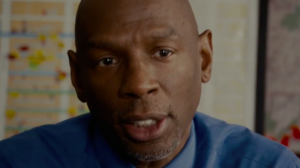“One of the saddest days of my life was when my mother told me Superman did not exist. I was like what do you mean he’s not real. And she thought I was crying because it’s like Santa Claus is not real and I was crying because there was no one coming with enough power to save us.”
-American social activist and educator, Geoffrey Canada
In Waiting For Superman (2010), director Davis Guggenheim explores the problems that exist within our educational system. Through a series of interviews with educational reformers such as Geoffrey Canada, and Michelle Rhee, and various families that portray the different faces of educational struggles, Guggenheim exposes the struggles many children face. Guggenheim centralizes the theme of “the lottery” in his film to describe what many families fear as their only and last chance. He focuses on charter schools and the promises that these schools have on their children, and how hopefully all of the children he interviewed receive the chance they deserve.
Waiting For Superman sheds light on the variety of problem parents, educators, administrators, and children face with education today. About four minutes into the film, the director Davis Guggenheim explains that the problem with the American Educational system is that we have a variety of schools that are considered as “bad,” and very few that are considered “good” or even “great” schools. Those great schools in turn, are extremely selective and most times, families earn a seat in the school by what Guggenheim describes as luck. He mentions that great schools are now offering seats to inner-city students through what he describes as a lottery. A lottery involves parents filling out an application and being given a number that would either be handpicked, computer generated, or chosen by a plastic ball. Guggenheim follows the stories of three families, the Esparza family, the Hill family, and the Jones family. All of the children’s parents show discontent in some form or shape towards the situation their children face, and test their luck within the lottery system.

Guggenheim introduces this perpetuating problem with our educational system by describing what “good schools” are. At 10:53, American social activist and educator, Geoffrey Canada notes that he would not had been as successful as he is if he attended his zone high school- Morris High School, in the South Bronx, NY. He questions what was the driving force behind the deterioration of our educational system. Through his interview with Guggenheim, Canada implies that the reasoning behind our failure lies in the fact that no one wants to take responsibility for our failing system, including all of our Presidents who were the first ones to promise change.

Guggenheim accentuates the problems that exist in our educational system through a series of interviews he holds with the families he followed throughout Waiting for Superman. In an interview with Francisco Esparza’s mother, he asks her to describe the school that her son attends (13:26) and she tells him that she does not know, because the moment one walks into the building, one is confronted by a security guard who will not let anyone in. Mrs. Maria Esparza is seen throughout the entire film trying to get into contact with her son’s teacher through various phone calls and letters in order to track her son’s progress, and receives no responses. In fact, her son’s teacher tells him that she does not need her sons work. That one scene explains one of the main reasons why our educational system is considered one of the worst. Within inner-city schools there is very little parent-teacher interaction. During her interview, Maria goes on and explains that her son is enrolled in one of the third largest school that is overcrowded in the Bronx. For most of the families interviewed public education was the only option that they had.

One particular scene that stands out in the entire documentary film, is at 16:30, where Guggenheim explains what some thought to be the savior of Education reform- the No Child Left Behind Act. Guggenheim strategically chose one of former President’s George W. Bushes’ speeches on the No Child Left Behind Act. In one scene, G.W.B states “I understand that taking tests aren’t fun…too bad.” Guggenheim had introduced NCLB as the remedy to our educational system, but portrayed George W. Bush as cold, and ultimately uncaring through his words. Through the NCLB act, the United States is to meet 100% proficiency in mathematics and reading by 2014. Guggenheim stated that in many states, eighth graders were below 20% in mathematics proficiency, and that in most states, when tested for reading proficiency, eighth graders scored between 20% and 35% of reading on grade level. Through these numbers, Guggenheim is portraying how much of a failure the No Child Left Behind Act was. Although most of the children, under this law are required to be tested on their proficiency, many are not passing or even reading and writing at grade level.

Guggenheim introduces Daisy, a young girl from Los Angeles who aspires to be a veterinarian and a surgeon, because she feels the need to help those in need. Guggenheim follows her path to Medical School by bringing forth Daisy’s chances of getting into Medical School based on the education she would be receiving in her zone-schools. At 21:03, the director introduces Roosevelt High School, one of Los Angeles’ zone-schools and an institution that is considered a “drop-out factory.” He notes the fact that only 3 out of every 100 students at Roosevelt graduate with the classes necessary in order to be considered for a four-year institution. He also mentions the fact that only 57% of its’ students graduate.
Davis Guggenheim explores what exactly drives the problem to increase within the schools that are considered as “bad” schools. He mentions the fact that certain teachers are given tenure, and that because of tenure; they are protected by contracts and allowed to have their job, regardless of their performance. Many educational reformers, teachers, principals, parents, and even the media recognize this, yet many schools fail to fight the system and fire teachers for their poor work.
Throughout the entire film, Guggenheim suggests that Private Schools may be one of the solutions for parents who seek to give their children a better education. Through Nakia and Bianca Jones’ interviews, Guggenheim portrays the struggles and successes of a family whose child is enrolled in a private parochial institution. Bianca Jones’ mother- Nakia, a single parent has her child enrolled in a parochial school, and struggles every month to make payments for her daughter’s tuition. Nakia chooses to keep her child enrolled despite the monetary problems. He suggests that private schools are a better solution during the beginning of the film, when he himself mentions that he drives past public schools on a daily basis to drive his own children to private schools.
Guggenheim explicitly states that “our schools haven’t changed, but the world around them has” (01:07:22), and because of this in order for our school systems to better, they have to be reformed to fit every child’s standards. Guggenheim models Summit High School, in Redwood, CA- a high school in where it’s students are not tracked as a model school. The director mentions how a middle class suburban family chose to send their child there because they had that option. The director also pays much attention to many charter schools throughout the country, that are much smaller in size and that have focuses, such as the arts. The only problem that exists with these particular schools is the fact that many of them are very small in size and run through the unfair lottery system. Guggenheim repeatedly states towards the end of the movie that the only thing that works in education reform is “applying the right accountability standards.” Although Guggenheim does not interview all different kinds of families, including those success stories- he does an excellent job at giving face to those families who are left behind because of the lottery system and a run down educational system.
On the Waiting For Superman website, Director Davis Guggenheim suggests the viewer take action by signing a petition that advocates for World-Class educational standards for all U.S. students.
Waiting for Superman. Dir. Davis Guggenheim. Paramount Vantage, 2010. Web.
According to Ambar, in “Waiting for Superman”, people like Geoffrey Canada comment on there past and how it affected where they are today. Canada specifically says that he would not have succeeded if he attended the local public school. Similarly, in “The Lottery”, they play on this aspect to promote charter schools. However, they do it a little differently. Rather than praising the charter schools for there good work, like I am assuming Canada is, “The Lottery” blames the local public school for the situation that Greg Jr.’s father is in. In other words, the film blames the local public school for Greg Sr. being in jail. Although different approaches, the tactic is the same and the argument for charter schools over public schools is the same.
Ambar,
“Waiting for Superman” seems like a very moving documentary. The emphasis on the lack of success of public schools and support towards charter schools is very interesting. The documentary I analyzed was “American Teacher” which was focused on what effective teachers bring to a classroom and how they are under appreciated.
In “American Teacher” the documentary “Waiting for Superman” is mentioned as a source of putting the arduous job of being an educator down. Although the two documentaries are very different they both seem to send influential messages to their viewers through interviews and scenes with children looking for success.
-Emma